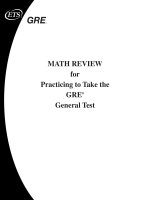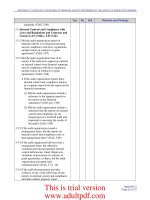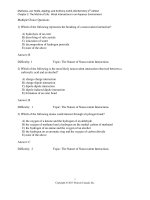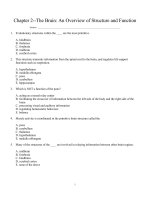Preview MCAT Biochemistry Review 20212022 (Kaplan Test Prep) by Kaplan Test Prep (2020)
Bạn đang xem bản rút gọn của tài liệu. Xem và tải ngay bản đầy đủ của tài liệu tại đây (2.07 MB, 56 trang )
MCAT® Biochemistry Review
2021–2022
Edited by Alexander Stone Macnow, MD
Table of Contents
MCAT Biochemistry Review
Cover
Title Page
Copyright
The Kaplan MCAT Review Team
Getting Started Checklist
Preface
About Scientific American
About the MCAT
How This Book Was Created
Using This Book
Studying for the MCAT
Chapter 1: Amino Acids, Peptides, and Proteins
1.1 Amino Acids Found in Proteins
1.2 Acid–Base Chemistry of Amino Acids
1.3 Peptide Bond Formation and Hydrolysis
1.4 Primary and Secondary Protein Structure
1.5 Tertiary and Quaternary Protein Structure
1.6 Denaturation
Chapter 2: Enzymes
2.1 Enzymes as Biological Catalysts
2.2 Mechanisms of Enzyme Activity
2.3 Enzyme Kinetics
2.4 Effects of Local Conditions on Enzyme Activity
2.5 Regulation of Enzyme Activity
Chapter 3: Nonenzymatic Protein Function and Protein Analysis
3.1 Cellular Functions
3.2 Biosignaling
3.3 Protein Isolation
3.4 Protein Analysis
Chapter 4: Carbohydrate Structure and Function
4.1 Carbohydrate Classification
4.2 Cyclic Sugar Molecules
4.3 Monosaccharides
4.4 Complex Carbohydrates
Chapter 5: Lipid Structure and Function
5.1 Structural Lipids
5.2 Signaling Lipids
5.3 Energy Storage
Chapter 6: DNA and Biotechnology
6.1 DNA Structure
6.2 Eukaryotic Chromosome Organization
6.3 DNA Replication
6.4 DNA Repair
6.5 Recombinant DNA and Biotechnology
Chapter 7: RNA and the Genetic Code
7.1 The Genetic Code
7.2 Transcription
7.3 Translation
7.4 Control of Gene expression in Prokaryotes
7.5 Control of Gene Expression in Eukaryotes
Chapter 8: Biological Membranes
8.1 Fluid Mosaic Model
8.2 Membrane Components
8.3 Membrane Transport
8.4 Specialized Membranes
Chapter 9: Carbohydrate Metabolism I: Glycolysis, Glycogen,
Gluconeogenesis, and the Pentose Phosphate Pathway
9.1 Glucose Transport
9.2 Glycolysis
9.3 Other Monosaccharides
9.4 Pyruvate Dehydrogenase
9.5 Glycogenesis and Glycogenolysis
9.6 Gluconeogenesis
9.7 The Pentose Phosphate Pathway
Chapter 10: Carbohydrate Metabolism II: Aerobic Respiration
10.1 Acetyl-CoA
10.2 Reactions of the Citric Acid Cycle
10.3 The Electron Transport Chain
10.4 Oxidative Phosphorylation
Chapter 11: Lipid and Amino Acid Metabolism
11.1 Lipid Digestion and Absorption
11.2 Lipid Mobilization
11.3 Lipid Transport
11.4 Cholesterol Metabolism
11.5 Fatty Acids and Triacylglycerols
11.6 Ketone Bodies
11.7 Protein Catabolism
Chapter 12: Bioenergetics and Regulation of Metabolism
12.1 Thermodynamics and Bioenergetics
12.2 The Role of ATP
12.3 Biological Oxidation and Reduction
12.4 Metabolic States
12.5 Hormonal Regulation of Metabolism
12.6 Tissue-Specific Metabolism
12.7 Integrative Metabolism
Glossary
Art Credits
ACKNOWLEDGMENTS
Editor-in-Chief, 2021–2022 Edition
Elizabeth Flagge
Contributing Editors, 2021–2022 Edition
Brandon Deason, MD, Chris Durland, Tyler Fara
Prior Edition Editorial Staff: Brandon Deason, MD, Christopher Durland, M. Dominic Eggert, Tyler
Fara, Elizabeth Flagge, Adam Grey, Lauren White
MCAT®is a registered trademark of the Association of American Medical Colleges, which neither
sponsors nor endorses this product.
This publication is designed to provide accurate and authoritative information in regard to the
subject matter covered. It is sold with the understanding that the publisher is not engaged in
rendering medical, legal, accounting, or other professional services. If legal advice or other expert
assistance is required, the services of a competent professional should be sought.
© 2020 by Kaplan, Inc.
Published by Kaplan Publishing, a division of Kaplan, Inc.
750 Third Avenue
New York, NY 10017
All rights reserved under International and Pan-American Copyright Conventions. By payment of the
required fees, you have been granted the non-exclusive, non-transferable right to access and read
the text of this eBook on screen. No part of this text may be reproduced, transmitted, downloaded,
decompiled, reverse engineered, or stored in or introduced into any information storage and
retrieval system, in any form or by any means, whether electronic or mechanical, now known or
hereinafter invented, without the express written permission of the publisher.
ISBN: 978-1-5062-6216-1
10 9 8 7 6 5 4 3 2 1
Kaplan Publishing print books are available at special quantity discounts to use for sales
promotions, employee premiums, or educational purposes. For more information or to purchase
books, please call the Simon & Schuster special sales department at 866-506-1949.
The Kaplan MCAT Review Team
Alexander Stone Macnow, MD
Editor-in-Chief
Tyra Hall-Pogar, PhD
Editor
Bela G. Starkman, PhD
Editor
Joshua D. Brooks, PhD
Kaplan MCAT Faculty
Alisha Maureen Crowley
Kaplan MCAT Faculty
Samer T. Ismail
Kaplan MCAT Faculty
Kelly Kyker-Snowman, MS
Kaplan MCAT Faculty
Christopher Lopez
Kaplan MCAT Faculty
Faculty Reviewers and Editors: Elmar R. Aliyev; James Burns; Jonathan
Cornfield; Brandon Deason, MD; Nikolai Dorofeev, MD; Benjamin Downer,
MS; Colin Doyle; Christopher Durland; M. Dominic Eggert; Marilyn Engle;
Eleni M. Eren; Raef Ali Fadel; Elizabeth Flagge; Adam Grey; Justine
Harkness; Scott Huff; Ae-Ri Kim, PhD; Elizabeth A. Kudlaty; Ningfei Li; John
P. Mahon; Matthew A. Meier; Nainika Nanda; Caroline Nkemdilim Opene;
Kaitlyn E. Prenger; Uneeb Qureshi; Derek Rusnak, MA; Kristen L. Russell,
ME; Michael Paul Tomani, MS; Nicholas M. White; Kerranna Williamson,
MBA; Allison Ann Wilkes, MS; and Tony Yu
Thanks to Kim Bowers; Eric Chiu; Tim Eich; Samantha Fallon; Tyler Fara;
Owen Farcy; Dan Frey; Robin Garmise; Rita Garthaffner; Joanna Graham;
Allison Harm; Beth Hoffberg; Aaron Lemon-Strauss; Keith Lubeley; Diane
McGarvey; Petros Minasi; John Polstein; Deeangelee Pooran-Kublall, MD,
MPH; Rochelle Rothstein, MD; Larry Rudman; Sylvia Tidwell Scheuring;
Carly Schnur; Karin Tucker; Lee Weiss; and the countless others who made
this project possible.
Getting Started Checklist
Preface
And now it starts: your long, yet fruitful journey toward wearing a white
coat. Proudly wearing that white coat, though, is hopefully only part of
your motivation. You are reading this book because you want to be a
healer.
If you're serious about going to medical school, then you are likely already
familiar with the importance of the MCAT in medical school admissions.
While the holistic review process puts additional weight on your
experiences, extracurricular activities, and personal attributes, the fact
remains: along with your GPA, your MCAT score remains one of the two
most important components of your application portfolio—at least early in
the admissions process. Each additional point you score on the MCAT
pushes you in front of thousands of other students and makes you an even
more attractive applicant. But the MCAT is not simply an obstacle to
overcome; it is an opportunity to show schools that you will be a strong
student and a future leader in medicine.
We at Kaplan take our jobs very seriously and aim to help students see
success not only on the MCAT, but as future physicians. We work with our
learning science experts to ensure that we're using the most up-to-date
teaching techniques in our resources. Multiple members of our team hold
advanced degrees in medicine or associated biomedical sciences, and are
committed to the highest level of medical education. Kaplan has been
working with the MCAT for over 50 years and our commitment to premed
students is unflagging; in fact, Stanley Kaplan created this company when
he had difficulty being accepted to medical school due to unfair quota
systems that existed at the time.
We stand now at the beginning of a new era in medical education. As
citizens of this 21st-century world of healthcare, we are charged with
creating a patient-oriented, culturally competent, cost-conscious,
universally available, technically advanced, and research-focused
healthcare system, run by compassionate providers. Suffice it to say, this is
no easy task. Problem-based learning, integrated curricula, and classes in
interpersonal skills are some of the responses to this demand for an
excellent workforce—a workforce of which you'll soon be a part.
We're thrilled that you've chosen us to help you on this journey. Please
reach out to us to share your challenges, concerns, and successes.
Together, we will shape the future of medicine in the United States and
abroad; we look forward to helping you become the doctor you deserve to
be.
Good luck!
Alexander Stone Macnow, MD
Editor-in-Chief
Department of Pathology and Laboratory Medicine
Hospital of the University of Pennsylvania
BA, Musicology—Boston University, 2008
MD—Perelman School of Medicine at the University of Pennsylvania, 2013
About Scientific American
As the world’s premier science and technology magazine, and the oldest
continuously published magazine in the United States, Scientific American
is committed to bringing the most important developments in modern
science, medicine, and technology to our worldwide audience in an
understandable, credible, and provocative format.
Founded in 1845 and on the “cutting edge” ever since, Scientific American
boasts over 150 Nobel laureate authors including Albert Einstein, Francis
Crick, Stanley Prusiner, and Richard Axel. Scientific American is a forum
where scientific theories and discoveries are explained to a broader
audience.
Scientific American published its first foreign edition in 1890, and in 1979
was the first Western magazine published in the People’s Republic of
China. Today, Scientific American is published in 14 foreign language
editions. Scientific American is also a leading online destination
(www.ScientificAmerican.com), providing the latest science news and
exclusive features to millions of visitors each month.
The knowledge that fills our pages has the power to spark new ideas,
paradigms, and visions for the future. As science races forward, Scientific
American continues to cover the promising strides, inevitable setbacks and
challenges, and new medical discoveries as they unfold.
About the MCAT
ANATOMY OF THE MCAT
Here is a general overview of the structure of Test Day:
Section
Number of
Time
Questions
Allotted
Test-Day Certification
4 minutes
Tutorial (optional)
10 minutes
Chemical and Physical Foundations of Biological
59
95 minutes
Systems
Break (optional)
Critical Analysis and Reasoning Skills (CARS)
10 minutes
53
Lunch Break (optional)
Biological and Biochemical Foundations of Living
90 minutes
30 minutes
59
95 minutes
Systems
Break (optional)
Psychological, Social, and Biological Foundations of
10 minutes
59
95 minutes
Behavior
Void Question
3 minutes
Satisfaction Survey (optional)
5 minutes
The structure of the four sections of the MCAT is shown below.
Chemical and Physical Foundations of Biological Systems
Time
Format
95 minutes
59 questions
10 passages
44 questions are passage-based, and 15 are discrete (stand-alone)
questions.
Score between 118 and 132
What It Tests
Biochemistry: 25%
Biology: 5%
General Chemistry: 30%
Organic Chemistry: 15%
Physics: 25%
Critical Analysis and Reasoning Skills (CARS)
Time
Format
90 minutes
53 questions
9 passages
All questions are passage-based. There are no discrete (stand-alone)
questions.
Score between 118 and 132
What It Tests
Disciplines:
Humanities: 50%
Social Sciences: 50%
Skills:
Foundations of Comprehension: 30%
Reasoning Within the Text: 30%
Reasoning Beyond the Text: 40%
Biological and Biochemical Foundations of Living Systems
Time
Format
95 minutes
59 questions
10 passages
44 questions are passage-based, and 15 are discrete (stand-alone)
questions.
Score between 118 and 132
What It Tests
Biochemistry: 25%
Biology: 65%
General Chemistry: 5%
Organic Chemistry: 5%
Psychological, Social, and Biological Foundations of Behavior
Time
Format
95 minutes
59 questions
10 passages
44 questions are passage-based, and 15 are discrete (stand-alone)
questions.
Score between 118 and 132
What It Tests
Biology: 5%
Psychology: 65%
Sociology: 30%
Total
Testing Time
375 minutes (6 hours, 15 minutes)
Total Seat
447 minutes (7 hours, 27 minutes)
Time
Questions
230
Score
472 to 528
SCIENTIFIC INQUIRY AND REASONING SKILLS (SIRS)
The AAMC has defined four Scientific Inquiry and Reasoning Skills (SIRS)
that will be tested in the three science sections of the MCAT:
1. Knowledge of Scientific Concepts and Principles (35% of questions)
2. Scientific Reasoning and Problem-Solving (45% of questions)
3. Reasoning About the Design and Execution of Research (10% of
questions)
4. Data-Based and Statistical Reasoning (10% of questions)
Let’s see how each one breaks down into more specific Test Day behaviors.
Note that the bullet points of specific objectives for each of the SIRS are
taken directly from the Official Guide to the MCAT Exam; the descriptions of
what these behaviors mean and sample question stems, however, are
written by Kaplan.
Skill 1: Knowledge of Scientific Concepts and Principles
This is probably the least surprising of the four SIRS; the testing of science
knowledge is, after all, one of the signature qualities of the MCAT. Skill 1
questions will require you to do the following:
Recognize correct scientific principles
Identify the relationships among closely related concepts
Identify the relationships between different representations of concepts
(verbal, symbolic, graphic)
Identify examples of observations that illustrate scientific principles
Use mathematical equations to solve problems
At Kaplan, we simply call these Science Knowledge or Skill 1 questions.
Another way to think of Skill 1 questions is as “one-step” problems. The
single step is either to realize which scientific concept the question stem is
suggesting or to take the concept stated in the question stem and identify
which answer choice is an accurate application of it. Skill 1 questions are
particularly prominent among discrete questions (those not associated
with a passage). These questions are an opportunity to gain quick points
on Test Day—if you know the science concept attached to the question,
then that’s it! On Test Day, 35% of the questions in each science section
will be Skill 1 questions.
Here are some sample Skill 1 question stems:
How would a proponent of the James–Lange theory of emotion
interpret the findings of the study cited in the passage?
Which of the following most accurately describes the function of FSH in
the human female menstrual cycle?
If the products of Reaction 1 and Reaction 2 were combined in solution,
the resulting reaction would form:
Ionic bonds are maintained by which of the following forces?
Skill 2: Scientific Reasoning and Problem-Solving
The MCAT science sections do, of course, move beyond testing
straightforward science knowledge; Skill 2 questions are the most
common way in which it does so. At Kaplan, we also call these Critical
Thinking questions. Skill 2 questions will require you to do the following:
Reason about scientific principles, theories, and models
Analyze and evaluate scientific explanations and predictions
Evaluate arguments about causes and consequences
Bring together theory, observations, and evidence to draw conclusions
Recognize scientific findings that challenge or invalidate a scientific
theory or model
Determine and use scientific formulas to solve problems
Just as Skill 1 questions can be thought of as “one-step” problems, many
Skill 2 questions are “two-step” problems, and more difficult Skill 2
questions may require three or more steps. These questions can require a
wide spectrum of reasoning skills, including integration of multiple facts
from a passage, combination of multiple science content areas, and
prediction of an experiment’s results. Skill 2 questions also tend to ask
about science content without actually mentioning it by name. For
example, a question might describe the results of one experiment and ask
you to predict the results of a second experiment without actually telling
you what underlying scientific principles are at work—part of the
question’s difficulty will be figuring out which principles to apply in order
to get the correct answer. On Test Day, 45% of the questions in each
science section will be Skill 2 questions.
Here are some sample Skill 2 question stems:
Which of the following experimental conditions would most likely yield
results similar to those in Figure 2?
All of the following conclusions are supported by the information in the
passage EXCEPT:
The most likely cause of the anomalous results found by the
experimenter is:
An impact to a man’s chest quickly reduces the volume of one of his
lungs to 70% of its initial value while not allowing any air to escape from
the man’s mouth. By what percentage is the force of outward air
pressure increased on a 2 cm2 portion of the inner surface of the
compressed lung?
Skill 3: Reasoning About the Design and Execution of Research
The MCAT is interested in your ability to critically appraise and analyze
research, as this is an important day-to-day task of a physician. We call
these questions Skill 3 or Experimental and Research Design questions for
short. Skill 3 questions will require you to do the following:
Identify the role of theory, past findings, and observations in scientific
questioning
Identify testable research questions and hypotheses
Distinguish between samples and populations and distinguish results
that support generalizations about populations
Identify independent and dependent variables
Reason about the features of research studies that suggest associations
between variables or causal relationships between them (such as
temporality and random assignment)
Identify conclusions that are supported by research results
Determine the implications of results for real-world situations
Reason about ethical issues in scientific research
Over the years, the AAMC has received input from medical schools to
require more practical research skills of MCAT test takers, and Skill 3
questions are the response to these demands. This skill is unique in that
the outside knowledge you need to answer Skill 3 questions is not taught
in any one undergraduate course; instead, the research design principles
needed to answer these questions are learned gradually throughout your
science classes and especially through any laboratory work you have
completed. It should be noted that Skill 3 comprises 10% of the questions
in each science section on Test Day.
Here are some sample Skill 3 question stems:
What is the dependent variable in the study described in the passage?
The major flaw in the method used to measure disease susceptibility in
Experiment 1 is:
Which of the following procedures is most important for the
experimenters to follow in order for their study to maintain a proper,
randomized sample of research subjects?
A researcher would like to test the hypothesis that individuals who
move to an urban area during adulthood are more likely to own a car
than are those who have lived in an urban area since birth. Which of the
following studies would best test this hypothesis?
Skill 4: Data-Based and Statistical Reasoning
Lastly, the science sections of the MCAT test your ability to analyze the
visual and numerical results of experiments and studies. We call these Data
and Statistical Analysis questions. Skill 4 questions will require you to do
the following:
Use, analyze, and interpret data in figures, graphs, and tables
Evaluate whether representations make sense for particular scientific
observations and data
Use measures of central tendency (mean, median, and mode) and
measures of dispersion (range, interquartile range, and standard
deviation) to describe data
Reason about random and systematic error
Reason about statistical significance and uncertainty (interpreting
statistical significance levels and interpreting a confidence interval)
Use data to explain relationships between variables or make predictions
Use data to answer research questions and draw conclusions
Skill 4 is included in the MCAT because physicians and researchers spend
much of their time examining the results of their own studies and the
studies of others, and it’s very important for them to make legitimate
conclusions and sound judgments based on that data. The MCAT tests Skill
4 on all three science sections with graphical representations of data
(charts and bar graphs) as well as numerical ones (tables, lists, and results
summarized in sentence or paragraph form). On Test Day, 10% of the
questions in each science section will be Skill 4 questions.
Here are some sample Skill 4 question stems:
According to the information in the passage, there is an inverse
correlation between:
What conclusion is best supported by the findings displayed in Figure 2?
A medical test for a rare type of heavy metal poisoning returns a positive
result for 98% of affected individuals and 13% of unaffected individuals.
Which of the following types of error is most prevalent in this test?
If a fourth trial of Experiment 1 was run and yielded a result of 54%
compliance, which of the following would be true?
SIRS Summary
Discussing the SIRS tested on the MCAT is a daunting prospect given that
the very nature of the skills tends to make the conversation rather
abstract. Nevertheless, with enough practice, you'll be able to identify
each of the four skills quickly, and you'll also be able to apply the proper
strategies to solve those problems on Test Day. If you need a quick
reference to remind you of the four SIRS, these guidelines may help:
Skill 1 (Science Knowledge) questions ask:









